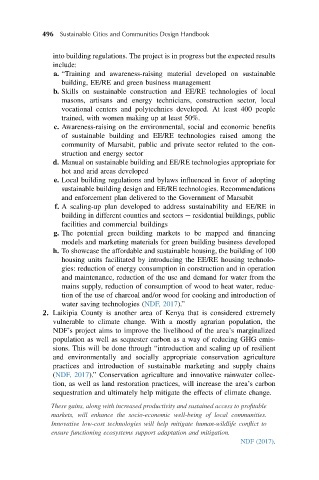Page 527 - Sustainable Cities and Communities Design Handbook
P. 527
496 Sustainable Cities and Communities Design Handbook
into building regulations. The project is in progress but the expected results
include:
a. “Training and awareness-raising material developed on sustainable
building, EE/RE and green business management
b. Skills on sustainable construction and EE/RE technologies of local
masons, artisans and energy technicians, construction sector, local
vocational centers and polytechnics developed. At least 400 people
trained, with women making up at least 50%.
c. Awareness-raising on the environmental, social and economic benefits
of sustainable building and EE/RE technologies raised among the
community of Marsabit, public and private sector related to the con-
struction and energy sector
d. Manual on sustainable building and EE/RE technologies appropriate for
hot and arid areas developed
e. Local building regulations and bylaws influenced in favor of adopting
sustainable building design and EE/RE technologies. Recommendations
and enforcement plan delivered to the Government of Marsabit
f. A scaling-up plan developed to address sustainability and EE/RE in
building in different counties and sectors e residential buildings, public
facilities and commercial buildings
g. The potential green building markets to be mapped and financing
models and marketing materials for green building business developed
h. To showcase the affordable and sustainable housing, the building of 100
housing units facilitated by introducing the EE/RE housing technolo-
gies: reduction of energy consumption in construction and in operation
and maintenance, reduction of the use and demand for water from the
mains supply, reduction of consumption of wood to heat water, reduc-
tion of the use of charcoal and/or wood for cooking and introduction of
water saving technologies (NDF, 2017).”
2. Laikipia County is another area of Kenya that is considered extremely
vulnerable to climate change. With a mostly agrarian population, the
NDF’s project aims to improve the livelihood of the area’s marginalized
population as well as sequester carbon as a way of reducing GHG emis-
sions. This will be done through “introduction and scaling up of resilient
and environmentally and socially appropriate conservation agriculture
practices and introduction of sustainable marketing and supply chains
(NDF, 2017).” Conservation agriculture and innovative rainwater collec-
tion, as well as land restoration practices, will increase the area’s carbon
sequestration and ultimately help mitigate the effects of climate change.
These gains, along with increased productivity and sustained access to profitable
markets, will enhance the socio-economic well-being of local communities.
Innovative low-cost technologies will help mitigate human-wildlife conflict to
ensure functioning ecosystems support adaptation and mitigation.
NDF (2017).

